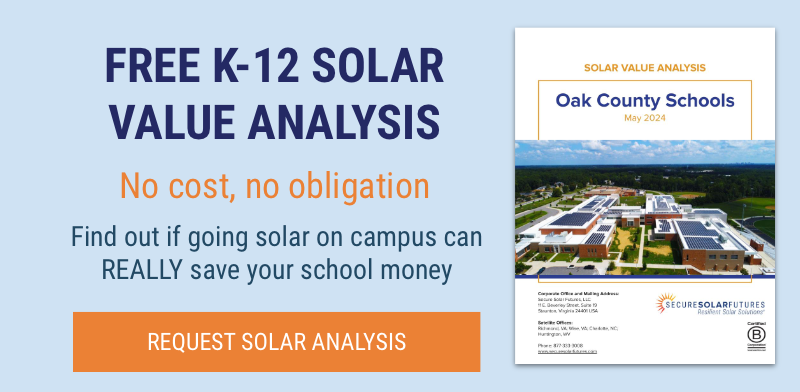Jun 27, 2024
Video: Virginia’s 2nd Largest School Division Shows How to Go Solar the Right Way
In some areas, K-12 schools can try to source clean energy from their local utility, but that may raise schools’ energy costs. By contrast, schools can actually save money while making a bigger impact by hosting their own solar power systems right on campus.
“As you can see here, we’ve got a photovoltaic array here on top of Beville Middle School,” explains Vernon Bock, Chief Operating Officer of Prince William County Schools, in a new video about the school division’s current solar project, developed and installed by Secure Solar Futures and our partner GOT Electric.
PWCS is a growing school system in Northern Virginia, one of the fastest growing areas in the United States. Between 1980 and 2022, the population of Prince William County increased from 144,703 to 467,900, requiring more schools and, of course, demanding more electric power. Schools making their own solar energy is part of the solution.
“The power that’s generated in the electricity that’s generated from these systems goes right into our school to supplement the electricity that we would otherwise be pulling from the grid,” Bock continues. “It’s a huge benefit to our community because it’s really reducing our overall energy cost. It’s increasing our efficiency. And then there’s a reduction of the greenhouse gas which goes out into the atmosphere in the environment.”
PWCS got solar at no upfront capital cost through a 25-year Power Purchase Agreement with Secure Solar Futures, allowing the schools to start saving money on energy from the first day. And savings are significant.
“Energy bills that we get within the school system on a building this size of 250,000 square feet are astronomical,” says Richard Facciolo with the schools’ Facilities Department. “Installing these solar panels is going to cut that in half, if not more. The sun is probably the biggest renewable resource we have, and for us to use it is about as responsible as we can get. Our roofs are flat, wide open and basically set up for the sun’s rays and, and anything that we can do to help supplement and decrease our energy usage is something we should absolutely strive for in Prince William County Schools.”
Saving money is only one of the reasons why PWCS decided to go solar on several of their campuses.
- With large buildings thirsty for power, saving energy would make more financial and environmental impact than school divisions with smaller buildings and fewer campuses
- Flat roofs offered ideal places to host commercial-scale solar arrays
- Teachers were as eager to offer hands-on lessons on clean energy as students were to learn about solar power right on campus
“I don’t think kids really know how science can be applied in their real lives until they kind of see how it really exists,” says Sixth Grade Science Teacher Minda Hunter. “So being able to be out here with the solar panels, seeing what they look like, and getting down and dirty with it, I think is really cool.”
Though the project faced several challenges, including supply chain delays on equipment and changed requirements from local electric utilities and county permitting offices, PWCS did not waver in their commitment to installing as much solar as they could in the first round of their project.
More solar may be in the schools’ future. Meantime, one of America’s largest school systems has set a strong example for schools across the country to follow when it comes to using on-campus solar to save money, go green, and offer hands-on education in clean energy to their students.
Would you like to see your schools go solar? Contact us to request a free K-12 Solar Value Analysis to determine whether your location or school system is a good candidate for on-campus solar power.

